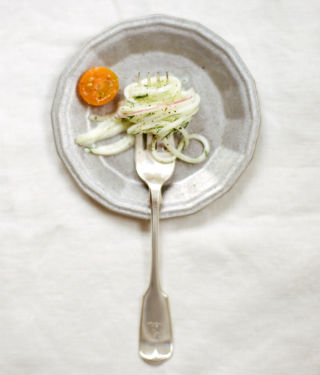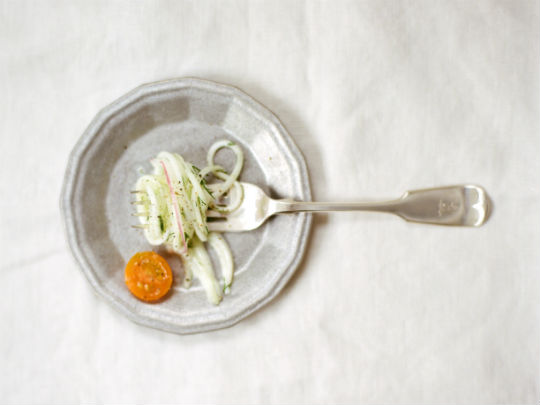http://www.marksdailyapple.com/
 This is a guest post from Diana Rodgers, the author of Paleo Lunches and Breakfasts on the Go, and The Homegrown Paleo Cookbook: Over 100 Delicious, Gluten-Free, Farm-to-Table Recipes, and a Complete Guide to Growing Your Own Healthy Food. Below is a recipe from her book using Primal Kitchen™ Mayo. In her book, you’ll also learn how to grow tomatoes, cucumbers, and the herbs needed for this recipe yourself! If you don’t have a green thumb and prefer to buy your produce at a farmer’s market, check out Diana’s tips following the recipe about how you can save money and still eat great on a Primal Blueprint diet. You can learn more about Diana at www.sustainabledish.com.
This is a guest post from Diana Rodgers, the author of Paleo Lunches and Breakfasts on the Go, and The Homegrown Paleo Cookbook: Over 100 Delicious, Gluten-Free, Farm-to-Table Recipes, and a Complete Guide to Growing Your Own Healthy Food. Below is a recipe from her book using Primal Kitchen™ Mayo. In her book, you’ll also learn how to grow tomatoes, cucumbers, and the herbs needed for this recipe yourself! If you don’t have a green thumb and prefer to buy your produce at a farmer’s market, check out Diana’s tips following the recipe about how you can save money and still eat great on a Primal Blueprint diet. You can learn more about Diana at www.sustainabledish.com.
Creamy Cucumber Noodle Salad with Cherry Tomatoes
Serves: 4
Long strings of cucumbers mixed with a creamy herb dressing and cherry tomatoes are so much fun served as a side with fish or grilled meat in the summer. My favorite cherry tomatoes are the variety Sun Gold, which we grow every year at the farm. They are less acidic than red tomatoes and have the most beautiful yellow/orange color, which has been my favorite hue since I was a little kid. If you’ve never used a spiral vegetable slicer before, you’ll be amazed at how easy it is to make noodles out of all kinds of vegetables. Just please watch out for the very sharp blades.
Ingredients:
- ½ cup Primal Kitchen Mayo
- Juice of 1 lemon
- ½ cup minced fresh dill
- ¼ cup minced fresh mint leaves
- ¼ cup very thinly sliced red onion
- 2 cucumbers, peeled
- 1 pint cherry tomatoes, sliced in half
- Sea salt and ground black pepper
Instructions:
- Mix the mayo, lemon juice, dill, and mint together in a small bowl. Set aside.
- Using a spiral vegetable slicer, spin the cucumbers into noodles.
- Place the cucumbers and red onion in a large bowl and toss with the dressing.
- Top with the sliced cherry tomatoes and season with salt and pepper to taste.
- Serve at once—this dish does not like to wait.
NOTE: This salad is also great with zucchini instead of cucumber.

How to Save Money and Still Eat
Have a plan
Menu planning is a lost art. If you figure out ahead of time what you’ll be eating when, it’s much easier to economize and save money on your grocery bill.
Cook and buy in bulk
It’s just as easy to roast multiple chickens as one, and with the oven already on, it’s simple to toss in a bunch of sweet potatoes. Is there a sale on your favorite olive oil? Stock up and save! Look for sales on meat at the market and add it to your stash. Not only is buying a whole or half of an animal more economical, it also lets you use more varied cuts than if you just purchase boneless, skinless chicken breasts or specialty steaks—so it’s a great way to explore the different cuts of meat.
Make your own bone broth
It’s the ultimate way to recycle a roast chicken or leg of lamb.
Grow your own food
While having your own chickens might cost more, the quality of the eggs far surpasses what you’ll get at the grocery store, and a veggie patch is a great way to save money. Live in a city? Maybe you can have container vegetables on the rooftop or fire escape, or you could tend a plot at a community garden.
Preserve the harvest
Freeze greens, can tomatoes, and make some sauerkraut. Not only will you save money, you’ll get to enjoy garden-grown produce in the middle of winter.
Dine in
Once you gain some confidence in the kitchen and get used to eating fantastic home-cooked food, you’ll think twice before spending your money on junky takeout or a mediocre steak at the local pub. Stay in and spend half of what you would have at the restaurant on your own home cooking. Don’t have much time? Scrambled eggs take less than five minutes. That’s faster and cheaper than ordering a pizza!
Buy local and in season
Local, seasonal produce is fresher than what you get at a supermarket and will last longer in your fridge. Instead of going to a farmers market and only picking out the most beautiful tomatoes, consider focusing your shopping trip on what is at its peak. Is it June? Strawberries and greens are what’s on the menu in New England. Is it January? Get some local cabbage, potatoes, carrots, and onions for a warm and satisfying stew. It’s much more sustainable and economical to build your weekly menu around what’s local and in season, and not whatever fancy recipe you crave at the moment.
Seek out less-expensive ingredients
Ground meat, organ meats, trash fish—fish that aren’t generally eaten in a particular region, such as carp in America—and unsexy vegetables like cabbage are better bets if you’re on a budget. At the farmers market, ask if they have “seconds”—vegetables that are blemished and not pretty enough for display. You could be canning extra tomatoes with a barrelful of tomato seconds at half price.
Not Sure What to Eat? Get the Primal Blueprint Meal Plan for Shopping Lists and Recipes Delivered Directly to Your Inbox Each Week
Filed under: Fitness

 For now classes are 6pm and 640pm at 2840 Wildwood st in the Boise Cloggers studio.
Book your class NOW!
click this ==>
For now classes are 6pm and 640pm at 2840 Wildwood st in the Boise Cloggers studio.
Book your class NOW!
click this ==>








